What are three functions supported by the Contrail Command user interface?
Exhibit.
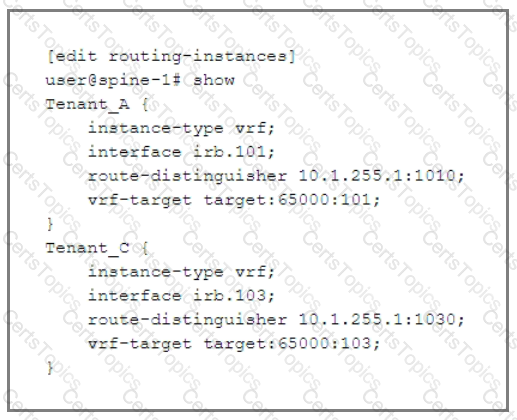
Referring to the exhibit, you want to advertise the IRB routes between both routing instances.
Which two statements are correct in this scenario? (Choose two.)
You are deploying your data center switches using ZTP.
A brand new QFX5120 switch has been booted for the first time. It is failing to upgrade to the desired Junos OS version.
In this scenario, which two actions would you take to troubleshoot this problem? (Choose two.)
You are building an IP fabric underlay network for your new data center. You must ensure that you have predictable load-balancing behavior throughout your network. According to Juniper Networks, what are two best practices that should be followed in this scenario? (Choose two.)
You are implementing perimeter security for your data center. You need to inspect all traffic Layer 7 and ensure the failure of a port or device will not result in an interruption to traffic flows. In this scenario, which design would satisfy these requirements?
Referring to the exhibit,
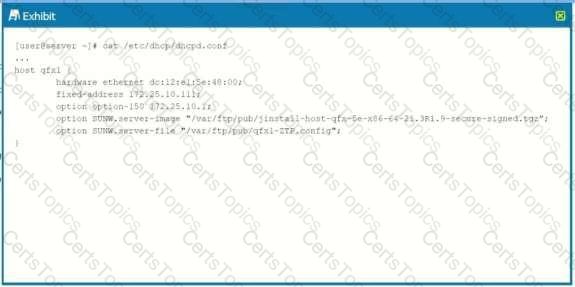
what happens when you initiate ZTP on a QFX5120 switch running Junos
21.3R1.9?
What happens when a packet is encapsulated by a VXLAN before being placed in the overlay?
A VXLAN adds 50 to 54 bytes of extra header information to an Ethernet frame. In this scenario,
how would you accommodate this increased?
Which two statements are true Virtual Chassis? (Choose two.)
Referring to the exhibit, each node in the IP fabric is peering to its directly attached neighbor
using EBGP. Each node is peering using physical interface IP addresses. Leaf 2 and Leaf 3 are advertising the 10.1.1/24 network into EBGP. Spine 2 must be configured so that it can load- share traffic destined to the 10 1.1/24 network over both next-hop A and next-hop B.
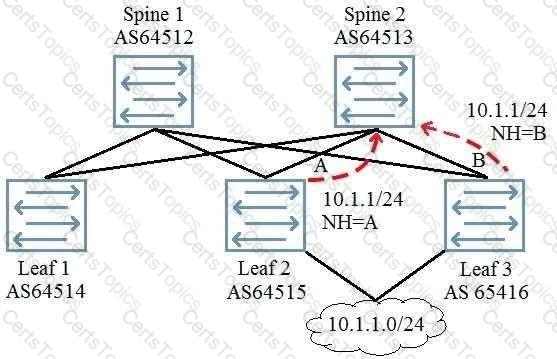
Which two actions must be performed to accomplish this task? (Choose two.)
You are asked to configure VXLAN for you c data center using multicast to exchange VTEP
information?
In this scenario, which two configuration parameters must match on the VTEPs in the same VXLAN segment? (Choose two.)
The two data centers shown in the exhibit need to be connected using EVPN. Which two statements are correct in this situation? (Choose two.)
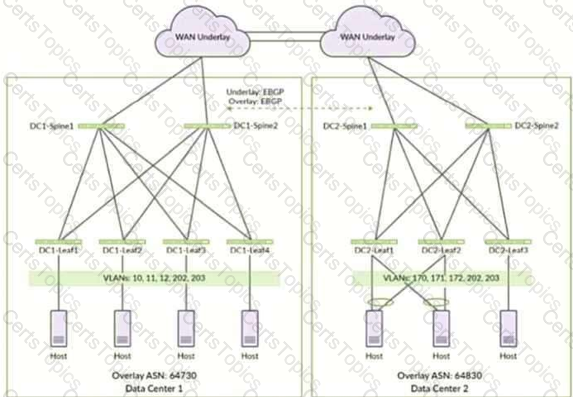
You are considering deploying a MAC-VRF type routing instance with a VLAN-bundle service
type. In this scenario, which two statements are correct? (Choose two.)
Which two statements describe EVPN based VXLAN implementations? (Choose two.)
When considering VRF routing-instances for network segmentation, which two statements are
true? (Choose two.)
You are deploying a VXLAN using signaling overlay network in your new data center. You are able to establish your MP BGP peering session and see your EVPN routes, but traffic will not traverse the VXLAN using signaling overlay network.
What is a solution to this problem?
An EVPN-signaled VXLAN overlay has been deployed in the network shown in the exhibit. Host1
is a bare metal server, and is dual-homed to the network. The IP addresses 10.1.1.1/24 and 10.1.1.2/24 are assigned to the same physical NIC, and no virtualization is configured on the server.
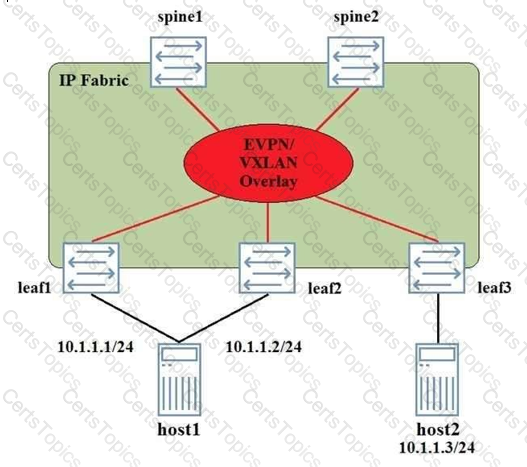
In this scenario, which two statements are true? (Choose two.)
You want to ensure high availability of the Junos devices in your data center. In this scenario, which three features would accomplish this task? (Choose three.)
Your manager asks you to secure ARP and DHCP traffic across your local Ethernet links In this
scenario, which technology will accomplish this task?
You are asked to enable visibility into your EVPN-VXLAN network traffic by monitoring traffi
continuously. Which two statements are correct in this scenario? (Choose two.)
Referring to the exhibit, what would cause the problem on VCP 0/50?
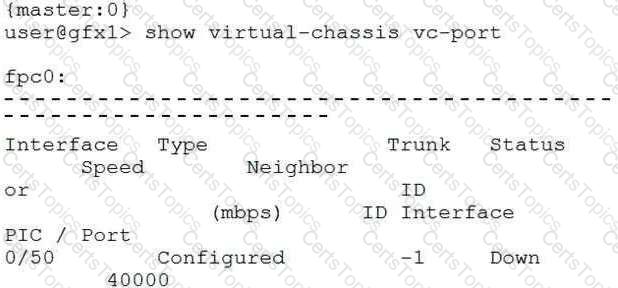
You choose the EBGP design shown in the exhibit as your IP fabric design. You must ensure that both routes received by the spine nodes will be used for ECMP forwarding.
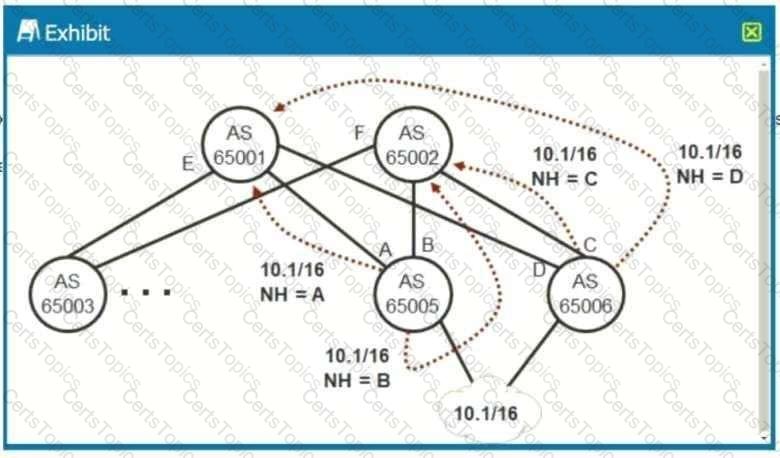
Which BGP parameter would need to be added to the EBGP configuration of the spine nodes to achieve this goal?
Which two statements are correct about a spine and leaf-based IP fabric? (Choose two.)
A customer wants to connect two data centers on different subnets using EVPN. What are two implications of using different IP subnets at each site? (Choose two.)
You have successfully deployed an IP fabric in your data center. However, your server team complains that they are not seeing an increase in performance as expected. After examining the routing and forwarding tables, you notice that only a single route is listed to each destination in the forwarding table, even though there are multiple routes shown in the routing table.
In this scenario, what should you do to solve the problem?
You are logged in to Leaf 1. When examining the routing table, you notice that you have no
routes from Leaf 2.
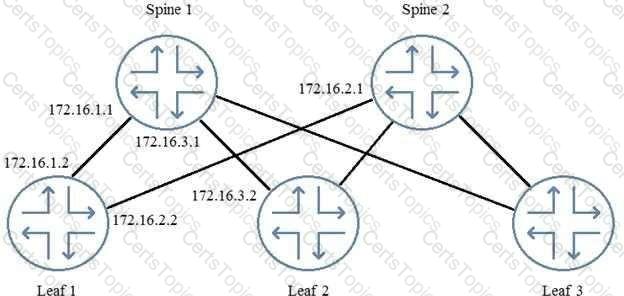
Referring to the exhibit, which two commands would you use to troubleshoot the problem? (Choosetwo.)
You are asked to configure your IP fabric with OSPF as the underlay routing protocol.
Which two statements are correct about this implementation? (Choose two.)
You are building an IP fabric underlay for your data center. You are asked to ensure that the two spine devices are in the same AS (65000) while the six leaf devices are in a different AS (65512). In this scenario, which two statements are correct by default? (Choose two.)
You are designing an IP fabric underlay network in your data center. You must ensure that your traffic can be forwarded at line rate.
In this scenario, which oversubscription model should be used?
Exhibit.

Referring to the output shown in the exhibit, which two statements are correct? (Choose two.)
Which protocol replicates forwarding information between MC-LAG peers?
Referring to the exhibit,
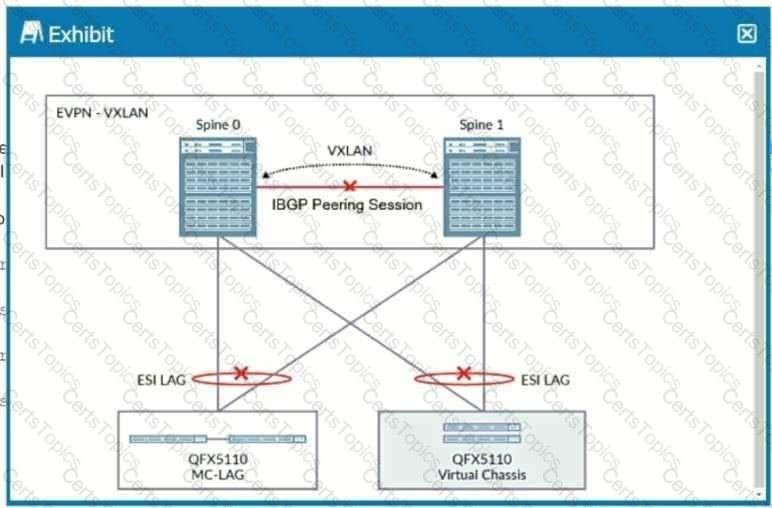
you have a data center in which only the spine devices are using EVPN and VXLAN. The leaf nodes are multihomed in active-active mode to the spine nodes through ESI LAG interfaces. In this design, a link failure on the interface connecting the spine nodes would also cause all traffic from the spine to the leaf nodes to drop.
In this scenario, which command configured on which nodes would solve this problem?
A VXLAN has been created between devices leaf1 and Ieaf3.
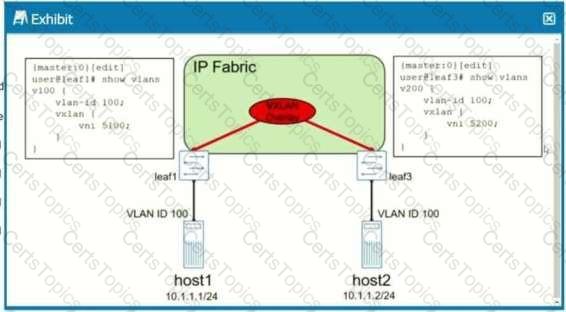
Referring to the exhibit, which statement is true?
What are two types of EVPN routes? (Choose two.)
Devices spine1 and spine have been configured as distributed Layer 3 gateways in the VXLAN topology, and devices leaf1 and leaf3 have been configured as layer 2 gateways. Device host must be able to communicate with device host?
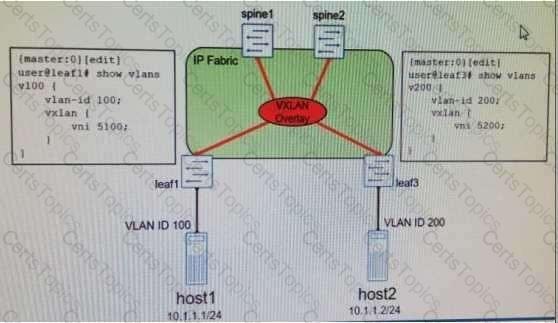
Which two statements are true? (Choose two.)
You must advertise reachability between two firewalls with unique IP subnets that terminate security services through your EVPN-VXLAN environment.
In this scenario, which EVPN route type should you enable to accomplish this task?
In an EVPN multicast environment, which two route types facilitate IGMP join and IGMP leave behavior for multihomed sites? (Choose two.)
Which two statements define the use of route targets and route distinguishers in an EVPN? (Choose two.)
Referring to the exhibit, which two statements are correct? (Choose two.)
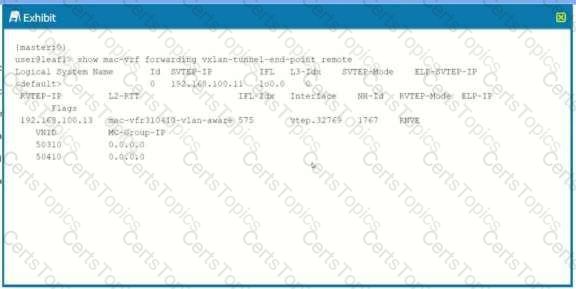
A client with five data centers spread around the country uses MPLS L2VPNs to provides point- to- point data center interconnect between each data center in a full-mesh network. The client Is considering an MPLS EVEN implementation.
In this scenario, what are three advantages of using MPL5 EVEN interconnects? (Choose two.)
Which EVPN router type prevents BUM traffic from looping back to a multihued host?
Referring to the VTEP output shown in the exhibit, which two statements are true?(Choose two.)
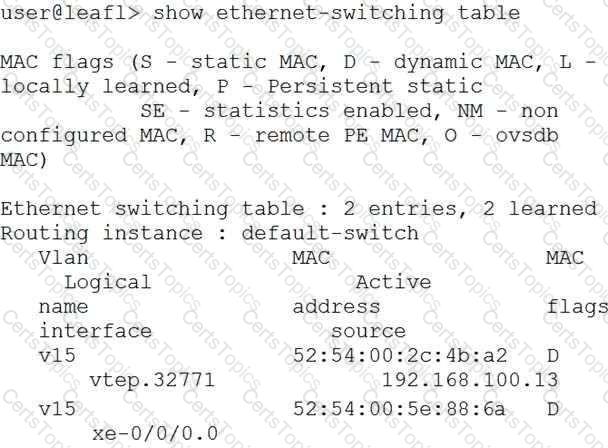
You host a multitenant data center that runs VMware. You must perform deep packet inspection
on all inter-tenant traffic that is flowing between the VMs within the same hypervisor. Your solution must provide the security services without needing to leave the physical device. In this scenario, what should you do to solve this problem?
What is the endpoint of a VXLAN tunnel?
You work in a data center where VMs and hosts are frequently moved. Your design needs to eliminate inefficient traffic flows.
In this scenario, which two solutions will satisfy this requirement? (Choose two.)